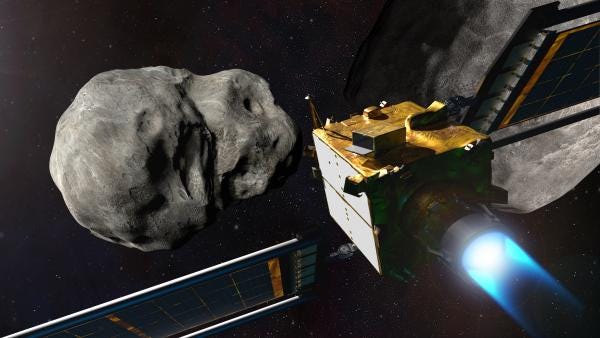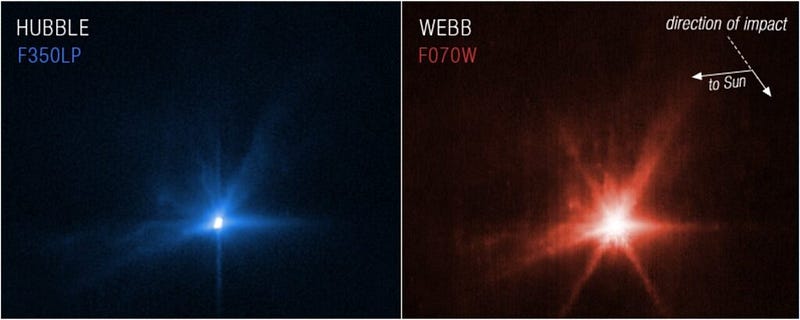DART Mission Triumphs: Impact on Asteroid Dimorphos
Written on
Chapter 1: DART's Historic Impact
On September 26, 2022, the Double Asteroid Redirection Test (DART) successfully collided with the 160-meter asteroid Dimorphos, captivating a worldwide audience. The spacecraft's onboard camera, DRACO, transmitted stunning images as DART approached the rocky surface, culminating in a brief final shot before losing signal.
This momentous event commenced when DART first focused on the larger binary asteroid, Didymos, as the spacecraft needed to distinguish between the two bodies. Approximately one hour before impact, the autonomous navigation system, known as SMART Nav, successfully identified and locked onto Didymoon. During a live stream hosted by the SETI Institute, DART Lead Investigator Andy Cheng confirmed that the spacecraft was on a direct path to its target. Soon after, Dimorphos appeared distinctly in the DRACO feed.
In the next 45 minutes, features of both Didymos and Dimorphos became visible, revealing them to be similar to rubble pile asteroids like Ryugu and the well-known Bennu. Observers noted boulders, craters, and even some flatter regions, with detailed analysis expected in the coming weeks.
As the impact time approached, Dimorphos gradually filled the camera's view until the spacecraft successfully struck its target, evoking cheers from the global audience.

Section 1.1: Celebrating a Milestone in Planetary Defense
NASA Administrator Bill Nelson hailed the DART mission as a groundbreaking achievement in planetary defense. He emphasized that this initiative not only showcases technological success but also represents a unified effort for the benefit of humanity. While NASA explores the cosmos, it remains committed to safeguarding our home planet. This mission transformed a concept once confined to science fiction into a practical reality, illustrating a method to protect Earth.
Following the impact, numerous telescopes worldwide, including ATLAS, ALMA Observatory, and the Hubble Space Telescope, were directed toward the collision site. Shortly after, ATLAS shared a social media post featuring a gif showing the Didymos system brightening and ejecting debris, confirming the successful impact.
The first video titled "Daily Space 27 September 2022: DART Mission Successfully Boops Dimorphos" provides further insights into this historic mission and the images captured during the impact.
Section 1.2: Awaiting Further Confirmation
One significant event awaited by scientists was the visual confirmation from DART's companion CubeSat, LICIACube, which was deployed 15 days prior to the impact. Though LICIACube is limited to a small antenna, it will relay images gradually over the next few weeks. The first two images were shared late on the night of the impact, contributing to the wealth of data that will help answer whether Dimorphos's orbit has indeed changed.
Anticipation builds as more information becomes available, and updates will be provided as NASA shares results.
The second video, "DART's Impact with Asteroid Dimorphos (Official NASA Broadcast)," captures the official broadcast of this significant event and its implications for future planetary defense strategies.
Chapter 2: Observations Post-Impact
In the wake of the DART collision, new images of the ejecta cloud emerged. In a historic first, both the Hubble Space Telescope and JWST captured simultaneous images of Dimorphos. JWST's infrared image revealed a compact core with surrounding ejecta, while Hubble's visible light image, taken shortly after the impact, showcased the expanding debris cloud.
JWST collected ten images over five hours and plans to gather spectroscopic data in the coming months. Hubble, on the other hand, captured a total of 45 images and will continue monitoring the ejecta cloud for changes.

Following the DART mission, the aftermath revealed a significant trail of debris extending from Dimorphos. Captured by the SOAR Telescope in Chile two days post-impact, the dust trail resembled a comet's tail, extending over 10,000 kilometers. Ongoing analysis will determine the amount of material ejected and the distribution of particle sizes in the dust cloud.
Astronomer Matthew Knight remarked that this marks the beginning of a new phase for the DART team as they sift through their data and collaborate with global observers to understand this exciting event.
More Information
- DART’s Small Satellite Companion Tests Camera Prior to Dimorphos Impact (NASA)
- ESA to capture light from deflected asteroid’s new plume (ESA)
- DLR press release
- NASA press release
- PSI press release
- ESA press release
- Hubblesite press release
- Webb Space Telescope press release
- NOIRLab press release
This story was crafted for the Daily Space podcast/YouTube series. For more updates from Dr. Pamela Gay and Erik Madaus, visit DailySpace.org.